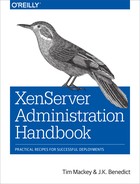Chapter 6. Understanding Guest VM Types
While XenServer supports many different operating systems, there are two types of Guest VM virtualization modes: hardware virtual machine (HVM) and para-virtualized (PV). While a third, PVHVM, will be briefly discussed, the primary distinction between these is related to the Guest VM’s operating system.
HVM Guests
HVM requires specialized extensions present in modern Intel and AMD processors. These extensions are known as Intel VT-x or AMD-V and allow the physical CPU to trap certain CPU instruction sets that operating systems normally use to interact with a bare metal server. Were an operating system to execute those instructions when virtualized, other VMs might be impacted.
HVM is commonly used when virtualizing an operating system such as Microsoft Windows where it isn’t possible to modify the operating system in order to make it virtualization aware. Because HVM guests have no awareness of their virtualization, they typically use emulated device drivers. In order to improve the performance of hardware-sensitive operations like disk or network access, HVM guests are usually installed with the XenServer tools. These tools provide operating system-specific drivers that are optimized for use in a XenServer environment and provide significant performance increase over an emulated driver.
PV Guests
Unlike HVM guests, para-virtualized guest VMs are aware they are virtualized and load an optimized kernel for the target hypervisor. Linux is a perfect example of an operating system that can be para-virtualized. While mainstream Linux distributions are generally Xen aware, certain distributions may require admins to recompile the kernel in order to enable Xen awareness. Historically, it was viewed that para-virtualization was the optimal solution for Linux guest VMs, but the most recent Linux releases include a kernel that is Xen aware and that operates in a cooperative manner with Xen, allowing these guests to perform best in HVM mode.
Microsoft Windows in XenServer
One can install and immediately virtualize a Windows Guest without PV drivers, also known as the XenServer Tools. The issue is that without the PV drivers, XenServer is providing emulated devices for the Windows Guest VM. Without the PV drivers, performance bottlenecks are quickly reached, particularly when some Windows VMs are used to run SQL Servers (Structured Query Language), Active Directory, and other infrastructure services. Additionally, the performance impact of emulation will lead to performance and scalability degradation in the XenServer host.
The XenServer tools provide optimized drivers for Windows network, storage, and video virtual hardware. These three components are key to running a high-performance Windows infrastructure, and as such, it is important that the XenServer tools used in a Windows VM match those for the XenServer host. Using older tools can lead to degraded performance and in certain circumstances degraded stability.
HVM versus Linux PV
As mentioned earlier, recent changes to Linux mean that Guest VMs perform optimally in HVM mode. Examples of these newer Linux distributions include CentOS 7, RHEL 7, Ubuntu 14.04, Debian Jessie, and SLES 12.
Looking to the Future with PVHVM
As the Xen hypervisor and XenServer continue to evolve, one of the most exciting features is that of PVHVM, or running Linux with HVM extensions. Overall, this is the most efficient form of virtualization and can be seen with Ubuntu, Debian, CentOS, and many popular releases with Xen-ready kernels. Still acting as a PV guest VM, PVHVM can leverage HVM extensions so that video and other aspects of the modern Linux experience can be leveraged.
